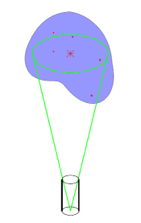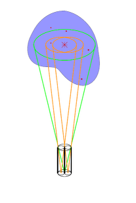
Essays
Published in 3 different nights, recurring, IMMA, Dublin, ISBN: 978-1-909792-15-9
Collecting the Light of Betelgeuse
Graham M Harper
The Concept
When Grace Weir first described her artistic experiment to record light from a bright star, I understood the concept but only appreciated part of the challenge. The light was to be manipulated as little as possible. She did not want any focusing optics such as one would find in a telescope; no lenses, no mirrors. A tube pointed at the star would collect the light and a photographic film at the end would be exposed. This was an astronomical instrument of sorts, but not a telescope, and Betelgeuse was the target.
This is much more difficult than one might first imagine. We are familiar with looking up at the night sky and immediately seeing the winter star, Betelgeuse. However, the human eye is a focusing device that increases the intensity of light by a factor of ~50,000 at the retina, so if our eye can form an image of a star in, say, a 1/50th second then without the eye's magnification it would take ~1000 seconds to record a signal. This becomes an issue for observing stars which travel in arcs across the night sky. Fortunately Grace had star-tracking equipment for her tripod which would keep the tube pointing at Betelgeuse.
Betelgeuse
Betelgeuse is an optically very bright star in the constellation of Orion. It is very bright because it is physically both very large, it is a red supergiant, and nearby astronomically speaking. It is towards the end of its life and when the fuel inside runs out it will become a supernova. It takes light about 640 years to travel from the star to the Earth. This means that the star may have already exploded and we do not know it, while this is extremely unlikely we are always looking at its past. The light recorded on the film will have left Betelgeuse about 1375 CE.
The Problem
Making sure that most of the photons recorded on film are from Betelgeuse
The role of the tube was not so much to collect starlight but to exclude as many unwanted light sources as possible, as illustrated Figure 1. Our criterion for the experiment was to make sure that MOST of the light recorded by the film was from Betelgeuse.
Collecting the Light of Betelgeuse
Graham M Harper
The Concept
When Grace Weir first described her artistic experiment to record light from a bright star, I understood the concept but only appreciated part of the challenge. The light was to be manipulated as little as possible. She did not want any focusing optics such as one would find in a telescope; no lenses, no mirrors. A tube pointed at the star would collect the light and a photographic film at the end would be exposed. This was an astronomical instrument of sorts, but not a telescope, and Betelgeuse was the target.
This is much more difficult than one might first imagine. We are familiar with looking up at the night sky and immediately seeing the winter star, Betelgeuse. However, the human eye is a focusing device that increases the intensity of light by a factor of ~50,000 at the retina, so if our eye can form an image of a star in, say, a 1/50th second then without the eye's magnification it would take ~1000 seconds to record a signal. This becomes an issue for observing stars which travel in arcs across the night sky. Fortunately Grace had star-tracking equipment for her tripod which would keep the tube pointing at Betelgeuse.
Betelgeuse
Betelgeuse is an optically very bright star in the constellation of Orion. It is very bright because it is physically both very large, it is a red supergiant, and nearby astronomically speaking. It is towards the end of its life and when the fuel inside runs out it will become a supernova. It takes light about 640 years to travel from the star to the Earth. This means that the star may have already exploded and we do not know it, while this is extremely unlikely we are always looking at its past. The light recorded on the film will have left Betelgeuse about 1375 CE.
The Problem
Making sure that most of the photons recorded on film are from Betelgeuse
The role of the tube was not so much to collect starlight but to exclude as many unwanted light sources as possible, as illustrated Figure 1. Our criterion for the experiment was to make sure that MOST of the light recorded by the film was from Betelgeuse.

Figure 1. The light collected by a tube includes Betelgeuse (big red star), diffuse galactic and sky background (shown in blue), and a myriad of fainter stars (small red stars) in the direction of Betelgeuse.
There will always be sources of contaminating light. When we look at Betelgeuse we see a bright twinkling reddish star surrounded by darkness. Unfortunately, it is not really dark at all. There are astrophysical and terrestrial sources of light contamination. In the Milky Way there are other stars in nearby lines-of-sight and also star-light scattered by tiny particles in interstellar space. Unwanted light sources from Earth depend on location, weather, and the night sky glow from the upper Earth's atmosphere caused by the Sun’s ultraviolet radiation, which in turn depends on how magnetically active the Sun is. Even if the background light is very faint, if you observe a large enough area of the night sky, the total background will eventually swamp the light from Betelgeuse.
So the question becomes: What tube length-to-diameter ratio will satisfy our criterion? We studied galactic sources first because they are easiest to determine. Using a database of stars called SIMBAD we found that a circle on the sky with a diameter of about 5 degrees would excludes enough unwanted starlight. A cardboard tube 72 cm in length and 6 cm in diameter tracking the star on its journey across the night sky might suffice. Grace made a test observation of Betelgeuse with Tube Version 1 from the West of Ireland and made a successful exposure, but what was the actual source of light recorded?
After evaluating Earthly sources we concluded that Version 1’s length-to-diameter ratio was not large enough to exclude sufficient unwanted light, and the West of Ireland was not dark enough for Grace's experiment.
If the tube were much longer it would not fit on the star-tracking tripod, if it were much narrower it would either become flimsy or require special materials and construction.
The Solution
The solution came while I was designing a flipped classroom for an undergraduate Astronomical Techniques module that I was teaching at the School of Physics in TCD. Grace wanted no focussing elements in her art experiment, and this reminded me of the early days of X-ray astronomy. Lenses and normal arrangement of mirrors do not work for X-rays, so early space observations (NASA Uhuru Satellite) used non-focusing techniques. For Uhuru a series of parallel metal tubes were mounted on the satellite that collimated the incoming astrophysical X-rays.
So the question becomes: What tube length-to-diameter ratio will satisfy our criterion? We studied galactic sources first because they are easiest to determine. Using a database of stars called SIMBAD we found that a circle on the sky with a diameter of about 5 degrees would excludes enough unwanted starlight. A cardboard tube 72 cm in length and 6 cm in diameter tracking the star on its journey across the night sky might suffice. Grace made a test observation of Betelgeuse with Tube Version 1 from the West of Ireland and made a successful exposure, but what was the actual source of light recorded?
After evaluating Earthly sources we concluded that Version 1’s length-to-diameter ratio was not large enough to exclude sufficient unwanted light, and the West of Ireland was not dark enough for Grace's experiment.
If the tube were much longer it would not fit on the star-tracking tripod, if it were much narrower it would either become flimsy or require special materials and construction.
The Solution
The solution came while I was designing a flipped classroom for an undergraduate Astronomical Techniques module that I was teaching at the School of Physics in TCD. Grace wanted no focussing elements in her art experiment, and this reminded me of the early days of X-ray astronomy. Lenses and normal arrangement of mirrors do not work for X-rays, so early space observations (NASA Uhuru Satellite) used non-focusing techniques. For Uhuru a series of parallel metal tubes were mounted on the satellite that collimated the incoming astrophysical X-rays.

Figure 2 illustrates that by using narrower tubes (packed inside the original) the area of night sky seen from the backend of each and thus the unwanted signal is reduced. Tube Version 2 had ~30 tubes (straws) within the original tube.
The practical solution for Grace’s experiment was to use the X-ray approach and to pack the end of the original tube with narrow black 22 by 0.5 cm drinking straws. Each straw had a large length-diameter ratio which reduced the contaminating light by a factor of 10. Further, by making the observation from a site of astronomical quality, the night sky glow caused by the Sun's radiation would become the limiting, but still unpredictable, contaminating light source. To be even more conservative we decided to double stack the straws - effectively doubling their length-to-diameter ratio and thus reducing the background by a further factor of four. Fortunately Grace located some longer black straws that made it easier to align and construct the collimator.
So Grace headed off to Mount Teide in Tenerife with Tube Version 2 and performed the experiment.
So Grace headed off to Mount Teide in Tenerife with Tube Version 2 and performed the experiment.
